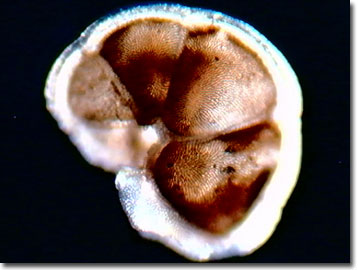Darkfield Digital Image Gallery
Foraminifera
Microscopic unicellular organisms, the Foraminifera are a wide-ranging marine taxon found at all depths worldwide. Constructing shells of various materials, following the death of the organisms, concentrations of their shells may achieve densities exceeding tens of thousands of individuals per cubic centimeter of sediment, which often occupy specialized ecological niches.

Species of foraminiferans are grouped on the basis of their being either planktonic (40 extant) or benthic (3,960 extant) in nature. In each group, shells vary in shape, size, and material, with a typical size range from 0.1 to 1 millimeter in diameter. For all of the planktonic and most benthic species, the shells (or tests) are composed of calcite, the same mineral comprising bivalve shells. Other benthic foram species construct shells consisting of organic material or cemented sediment particles or secreted minerals such as silica or aragonite. The pink sands of Bermuda get their color from the foraminiferan Homotrema rubrum, which has pink to red-colored shells. The shells of living and extinct species of foraminifera make up a substantial proportion of the deep ocean sediments.
The tests of most forams are chambered, allowing additions for growth, although some species display simpler open tube or hollow sphere configurations. Radiating from the opening of the shell are fine, hair-like reticulopodia, used for finding and capturing prey items such as bacteria, diatoms, copepods, and single-celled phytoplankton. Near the base of the marine food web, many species of snails, sand dollars, and fishes are supported by grazing (some very selectively on particular species) on forams. Although a single-celled protist, an individual foraminiferan may have many nuclei within its cell. One extant species, the largest known, has a symbiotic relationship with algae that grow within its shells.
The fossil record of benthic foraminiferans dates back more than 550 million years (back into the Late Precambrian or Proterozoic Era) with planktonic species appearing more recently, at 190 million years in the past (Jurassic Period of the Mesozoic Era). Since each species of this shelled protozoan only lasted from 5 to 15 million years, a relatively brief period in geologic time, foraminiferans are extremely useful for determining the age of sediments and have become an important tool for petroleum geologists, climatologists, evolutionary biologists, and paleontologists.
Contributing Authors
Cynthia D. Kelly, Thomas J. Fellers and Michael W. Davidson - National High Magnetic Field Laboratory, 1800 East Paul Dirac Dr., The Florida State University, Tallahassee, Florida, 32310.
BACK TO THE DARKFIELD IMAGE GALLERY
BACK TO THE DIGITAL IMAGE GALLERIES
Questions or comments? Send us an email.
© 1995-2022 by Michael W. Davidson and The Florida State University. All Rights Reserved. No images, graphics, software, scripts, or applets may be reproduced or used in any manner without permission from the copyright holders. Use of this website means you agree to all of the Legal Terms and Conditions set forth by the owners.
This website is maintained by our
Graphics & Web Programming Team
in collaboration with Optical Microscopy at the
National High Magnetic Field Laboratory.
Last Modification Friday, Nov 13, 2015 at 02:19 PM
Access Count Since September 17, 2002: 14356
Visit the website of our partner in introductory microscopy education:
|
|
